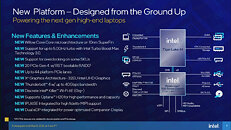Wednesday, May 5th 2021

11th Gen Intel Core-H Specs Leaked: 8-core "Tiger Lake" a Reality
Intel's fabled 8-core "Tiger Lake-H" silicon built on the 10 nm SuperFin process, is close to reality. The company's upcoming 11th Gen Core "Tiger Lake-H" processors for performance- and gaming notebooks, leverages this die. An HD Tecnologia report leaks alleged company slides from Intel that detail the processor line up and feature-set. To begin with, the 11th Gen Core-H series processors come in core-counts ranging from 4-core/8-thread, to 6-core/12-thread, and 8-core/16-thread. Look at the embargo date on the leaked slides, one could expect a formal launch as close as May 11, 2021.
The 10 nm SuperFin "Tiger Lake-H" silicon features 8 "Willow Cove" CPU cores, and an updated iGPU based on the company's latest Gen12 Xe LP graphics architecture. Each of the eight CPU cores has 1.25 MB of L2 cache, and they share a massive 24 MB of L3 cache. The Gen12 Xe LP iGPU only has 32 execution units (EUs), according to the slides, 1/3rd those of the 96 EUs on the "Tiger Lake-U." The uncore component is also updated, now featuring dual-channel DDR4-3200 native support, and a 28-lane PCI-Express 4.0 root-complex. 16 of these lanes are wired out as PEG (PCI-Express Graphics), four as a CPU-attached NVMe slot, and eight toward the 8-lane DMI 3.0 chipset bus.The lineup is led by the Core i9-11980HK, this generation's flagship SKU, designed for "halo" segment gaming laptops. This chip maxes out the "Tiger Lake-H" silicon, runs the 8 CPU cores at speeds of up to 5.00 GHz, and has a rated TDP of 65 W. It is also unlocked for overclocking. This part is followed by the i9-11900H, with the same hardware features, but lacking in overclocking features; boost frequency of up to 4.90 GHz, and TDP of 45 W. The Core i7-11800H has the same 8-core/16-thread core-count as the Core i9 parts, but with lower clock speeds of up to 4.60 GHz.The Core i5 SKUs within this lineup are 6-core/12-thread, and come with 12 MB of shared L3 cache (as opposed to the expected 18 MB, if we were to go buy the logic of 3 MB L3$ slices per core on the silicon). The Core i5-11400H and i5-11260H boost at frequencies of up to 4.10 GHz and 4.00 GHz, respectively; and come with 35 W TDP. The already-launched Core i7-11370H presents an anomaly to this lineup. Based on the same 4-core/8-thread silicon as the "Tiger Lake-U" silicon, with its TDP bumped up to 28 W, this is a U-segment processor buffed up to be H-segment.Intel in its presentation, trained its guns on AMD's Ryzen 9 5900HS processor to compare with its Core i5-11400H part. The company is banking heavily on the high IPC of its "Willow Cove" CPU cores to see its performance-price equation through against the "Zen 3" based Ryzen 5000H/HS series.
Besides the up to 20 PCIe Gen 4 lanes from the processor, the chipset puts out up to 24 PCI-Express Gen 3.0 downstream lanes. Platform I/O updates include support for Thunderbolt 4 (40 Gbps), and Wi-Fi 6E.
Sources:
HD Tecnologia, VideoCardz
The 10 nm SuperFin "Tiger Lake-H" silicon features 8 "Willow Cove" CPU cores, and an updated iGPU based on the company's latest Gen12 Xe LP graphics architecture. Each of the eight CPU cores has 1.25 MB of L2 cache, and they share a massive 24 MB of L3 cache. The Gen12 Xe LP iGPU only has 32 execution units (EUs), according to the slides, 1/3rd those of the 96 EUs on the "Tiger Lake-U." The uncore component is also updated, now featuring dual-channel DDR4-3200 native support, and a 28-lane PCI-Express 4.0 root-complex. 16 of these lanes are wired out as PEG (PCI-Express Graphics), four as a CPU-attached NVMe slot, and eight toward the 8-lane DMI 3.0 chipset bus.The lineup is led by the Core i9-11980HK, this generation's flagship SKU, designed for "halo" segment gaming laptops. This chip maxes out the "Tiger Lake-H" silicon, runs the 8 CPU cores at speeds of up to 5.00 GHz, and has a rated TDP of 65 W. It is also unlocked for overclocking. This part is followed by the i9-11900H, with the same hardware features, but lacking in overclocking features; boost frequency of up to 4.90 GHz, and TDP of 45 W. The Core i7-11800H has the same 8-core/16-thread core-count as the Core i9 parts, but with lower clock speeds of up to 4.60 GHz.The Core i5 SKUs within this lineup are 6-core/12-thread, and come with 12 MB of shared L3 cache (as opposed to the expected 18 MB, if we were to go buy the logic of 3 MB L3$ slices per core on the silicon). The Core i5-11400H and i5-11260H boost at frequencies of up to 4.10 GHz and 4.00 GHz, respectively; and come with 35 W TDP. The already-launched Core i7-11370H presents an anomaly to this lineup. Based on the same 4-core/8-thread silicon as the "Tiger Lake-U" silicon, with its TDP bumped up to 28 W, this is a U-segment processor buffed up to be H-segment.Intel in its presentation, trained its guns on AMD's Ryzen 9 5900HS processor to compare with its Core i5-11400H part. The company is banking heavily on the high IPC of its "Willow Cove" CPU cores to see its performance-price equation through against the "Zen 3" based Ryzen 5000H/HS series.
Besides the up to 20 PCIe Gen 4 lanes from the processor, the chipset puts out up to 24 PCI-Express Gen 3.0 downstream lanes. Platform I/O updates include support for Thunderbolt 4 (40 Gbps), and Wi-Fi 6E.





13 Comments on 11th Gen Intel Core-H Specs Leaked: 8-core "Tiger Lake" a Reality
Also "Intel Killer" WiFi? I mean, I know they've worked together for a while, but has Intel bought Killer?
That's also a boatload of PCIe lanes for a notebook platform.
I can imagine how this played out: Killer probably fell back on payments to Intel for its PHYs/WLAN cards, and offered to be bought out.
If you can't even double the core count of Tiger Lake all that easily, then doubling core count AGAIN (plus adding atoms) is n not gong to be any easier!
The final straw that broke the Alder's back is the fact that both of these chips are new architectures (Intel has never done all of this in a single step before)
Speaking of PCIe, the slide mentions RST bootable RAID0 support off of the CPU's lanes; last time I checked, with Intel you can only create a CPU-attached RAID0 using Intel-branded SSDs. Intel doesn't, to my knowledge, have any PCIe 4.0 NVMe drives available for the consumer market so either:
A. Intel is going to release some, or
B. Intel is going to open up CPU-attached RAID to non-Intel SSDs for this platform only, which is going to royally piss off people who bought X299.
With intel's better availability and platform support we should see interesting new models coming
This doesn't look good for 10nm/ SuperFin, especially when Intel's 7nm is still at least a couple of years away. 10nm is denser for sure, but also looks to be very power hungry. I wonder how much power it will require to hit the base clock and what will be the PL2 value to reach those lofty 4 .2 to 4.6GHz clockspeed.Desktop will get Alder Lake which is supposed to be released later this year. Rocket Lake is a stop gap solution which they have planned years ago when Intel knew that their 10nm will be late.
In my opinion, Intel's products are seriously messed up. The reason why I said that is because, Alder Lake sounds like something that will benefit mobile/ laptops with their big/little core configuration, but strangely will debut for desktop. On the other hand, Tiger Lake S seems to be better off on desktop, but ended up for mobile/ laptops. And for the last few years, they have overlapping products in the mobile space, where they have a combination of 14nm and 10nm chips for the same segment. Intel is obviously doing damage control by trying to rush products out, but I don't think it is doing them much good. Rather I prefer to eat humble pie and plan properly. I may be wrong, but that is the vibe I am getting from the news I see and thus, my opinion.At least from what I observed, Intel's current 10nm lineup still struggles with high power consumption, evident with the many opportunistic boost that Intel is gradually adding. In addition, I also noticed that the base clockspeed may require a higher power consumption than the 35W cTDP as shown in the slide showing the specs. In comparison, AMD's Cezanne chips are running significantly higher base clockspeed, although nothing is mentioned about whether these base clockspeed are running at their respective TDP. That is the usual assumption.
www.anandtech.com/show/16405/amd-launches-ryzen-5000-mobile-zen-3-and-cezanne-for-notebooks
I guess avx512 makes numbers lower; base frequency is tipically the speed the cpu would sustain at TDP with the highest load possible on the cores, and as we've seen, avx512 can consume quite a bit of energy and thus that will push the base frequency down.
I suspect freq@cTDP is the "base frequency" as it was always defined. "Base freq" is maybe defined as a base speed comparable to previous gen (10th) and AMD CPUs, perhaps omitting avx512 usage in order to make comparisons "fair".
If my assumptions are correct, then we do see an improvement in base frequency across the entire stack compared to 10th-gen. 6-cores are doing even better, because they are 10w below their counterparts (35w vs 45w TDP).